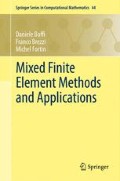Abstract
Although we shall not define in this chapter mixed and hybrid (or other non-standard) finite element methods in a very precise way, we would like to situate them in a sufficiently clear setting. As we shall see, boundaries between different methods are sometimes rather fuzzy. This will not be a real drawback if we nevertheless know how to apply correctly the principles underlying their analysis.
Access this chapter
Tax calculation will be finalised at checkout
Purchases are for personal use only
References
D.A. Adams. Sobolev spaces. Academic Press, New York, 1975.
J.P. Aubin. L’analyse non linéaire et ses motivations économiques. Masson, Paris, 1984.
V. Barbu and T. Precupanu. Convexity and optimization in Banach spaces. Editura Academiei, Bucarest, 1978.
K.J. Bathe. Finite Element Procedures in Engineering Analysis. Prentice Hall, Englewood Cliffs, N.J., 1982.
J.H. Bramble, R.D. Lazarov, and J.E. Pasciak. Least-squares for second order elliptic problems. Comp. Meth. Appl. Mech. Engng., 152:195–210, 1998.
F. Brezzi, M. Fortin, and L. D. Marini. Mixed finite element methods with continuous stresses. Math. Models Methods Appl. Sci., 3(2), 1993.
J. Céa. Approximation variationnelle des problèmes aux limites. Ann. Inst. Fourier, 14:2, 1964.
P.G. Ciarlet. The finite element method for elliptic problems. North-Holland, Amsterdam, 1978.
P.G. Ciarlet. Mathematical elasticity. Vol. I. North-Holland Publishing Co., Amsterdam, 1988. Three-dimensional elasticity.
P.G. Ciarlet. Mathematical elasticity. Vol. II. North-Holland Publishing Co., Amsterdam, 1997. Theory of plates.
P.G. Ciarlet and P. Destuynder. A justification of the two-dimensional linear plate model. J. Mécanique, 18:315–344, 1979.
P.G. Ciarlet and P.A. Raviart. A mixed finite element method for the biharmonic equation. In C. de Boor, editor, Mathematical Aspects of Finite Element in Partial Differential Equations. Academic Press, New York, 1974.
P. Constantin and C. Foias. Navier-Stokes Equations. University of Chicago Press, Chicago, 1988.
R. Dautray and J.-L. Lions. Mathematical analysis and numerical methods for science and technology. Vol. 1. Springer-Verlag, Berlin, 1990.
R. Dautray and J.L. Lions. Analyse mathématique et calcul numérique pour les sciences et les techniques. Collection Commissariat à l’Energie Atomique. Masson, Paris, 1984.
J. Dieudonné. Foundation of Modern Analysis. Institut des Hautes Études Scientifiques, Paris. Academic Press, New York and London, 1960.
J. Douglas and J. Wang. An absolutely stabilized finite element method for the Stokes problem. Math. Comput., 52:495–508, 1989.
I. Ekeland and R. Temam. Analyse convexe et problèmes variationnels. Dunod Gauthier Villars, Paris, 1974.
M. Fortin and R. Glowinski. Augmented Lagrangian methods. North-Holland, Amsterdam, 1983.
M. Fortin and Guenette R. A new mixed finite element method for computing viscoelastic flows. J. Non-Newtonian Fluid Mech., 60:27–52, 1995.
B. Fraeijs de Veubeke. Displacement and equilibrium models in the finite element method. In O.C. Zienkiewicz and G. Holister, editors, Stress Analysis. John Wiley and Sons, New York, 1965.
L.P. Franca. New mixed finite element methods. PhD thesis, Appl. Mech. Divi., Stanford University, 1987.
P. Grisvard. Elliptic Problems in Non-Smooth Domains. Pitman, London, 1985.
K. Hellan. Analysis of elastic plates in flexure by a simplified finite element method, volume 46 of Civil Engineering Series. Acta Polytechnica Scandinavia, Trondheim, 1967.
L.R. Herrmann. Finite element bending analysis for plates. J. Eng. Mech. Div. ASCE, 93, EM5:13–26, 1967.
R. Hiptmair. Canonical construction of finite elements. Math. Comp., 68(228):1325–1346, 1999.
T.J.R. Hughes. The finite element method: linear static and dynamic finite element analysis. Prentice-Hall, Englewood Cliffs N.J., 1987.
T.J.R. Hughes and L.P. Franca. A new finite element formulation for computational fluid dynamics: VII. the Stokes problem with various well-posed boundary conditions, symmetric formulations that converge for all velocity-pressure spaces. Comp. Meth. Appl. Mech. Eng., 65:85–96, 1987.
N. Kikuchi and J.T. Oden. Contact problems in Elasticity: A Study of Variational Inequalities and Finite Element Methods. SIAM Studies in Applied mathematics. SIAM, Philadelphia, 1988.
L. D. Landau and E. M. Lifshitz. Course of theoretical physics. Vol. 8. Pergamon International Library of Science, Technology, Engineering and Social Studies. Pergamon Press, Oxford, 1984.
R. Leis. Initial-boundary value problems in mathematical physics. B. G. Teubner, Stuttgart, 1986.
P.G. Lemarié-Rieusset. Recent Developments in the Navier-Stokes Problem. CRC Research Notes in Mathematics 431. Chapman and Hall, Boca Raton, 2002.
J.L. Lions and E. Magenes. Problèmes aux limites non-homogènes et applications. Dunod, Paris, 1968.
J.E. Marsden and T.J.R. Hughes. Mathematical Foundations of Elasticity. Prentice Hall, New York, 1983.
B. Mercier. Numerical solution of the biharmonic problem by mixed finite elements of class C 0. Boll. U.M.I., 10:133–149, 1974.
J. Nečas. Les méthodes directes en théorie des équations elliptiques. Masson, Paris, 1967.
T.H.H. Pian. Formulations of finite element methods for solid continua. In R.H. Gallagher, Y. Yamada, and J.T. Oden, editors, Recent Advances in Matrix Methods Structural Analysis and Design. The University of Alabama Press, Alabama, 1971.
T.H.H. Pian and P. Tong. Basis of finite element methods for solid continua. Int. J. Num. Meth. Eng., 1:3–28, 1969.
P.A. Raviart and J.M. Thomas. Introduction à l’analyse numérique des équations aux dérivées partielles. Masson, Paris, 1983.
E. Reisnerr. On a variational theorem for finite elastic deformations. J. Math. Physics, 32:129–135, 1953.
E. Reisnerr. On the variational theorem in elasticity. J. Math. Physics, 29:90–95, 1958.
R.T. Rockafellar. Convex Analysis. Princeton University Press, Princeton, N.J., 1970.
H. Sohr. The Navier-Stokes Equations. Birkhauser, Basel, 2008.
R. Temam. Navier-Stokes Equations and Nonlinear Functional Analysis, 2nd Ed. SIAM, Philadelphia, 1995.
F. Thomasset. Implementation of finite element methods for Navier–Stokes Equations. Springer Series in Comp. Physics. Springer-Verlag, Berlin, 1981.
P. Tong and T.H.H. Pian. A variational principle and the convergence of a finite element method based on assumed stress distribution. Int. J. Solids Struct., 5:463–472, 1969.
K. Yosida. Functional analysis. Springer-Verlag, New York, 1966.
O.C. Zienkiewicz. The finite element method. McGraw-Hill, London, 1977.
Author information
Authors and Affiliations
Rights and permissions
Copyright information
© 2013 Springer-Verlag Berlin Heidelberg
About this chapter
Cite this chapter
Boffi, D., Brezzi, F., Fortin, M. (2013). Variational Formulations and Finite Element Methods. In: Mixed Finite Element Methods and Applications. Springer Series in Computational Mathematics, vol 44. Springer, Berlin, Heidelberg. https://doi.org/10.1007/978-3-642-36519-5_1
Download citation
DOI: https://doi.org/10.1007/978-3-642-36519-5_1
Published:
Publisher Name: Springer, Berlin, Heidelberg
Print ISBN: 978-3-642-36518-8
Online ISBN: 978-3-642-36519-5
eBook Packages: Mathematics and StatisticsMathematics and Statistics (R0)

